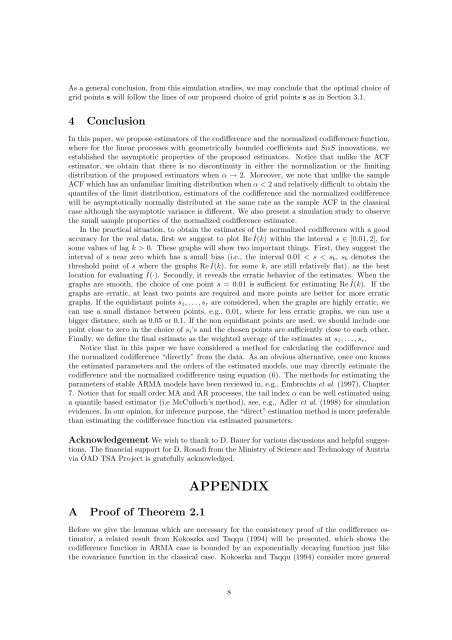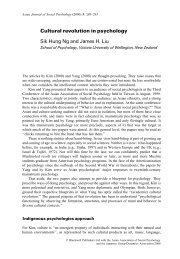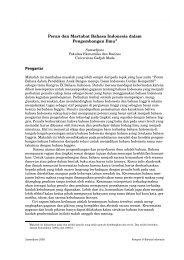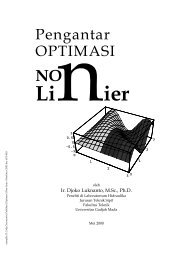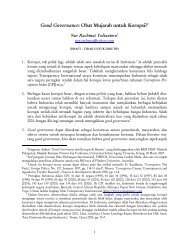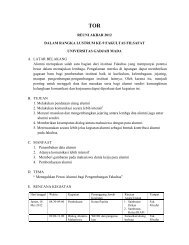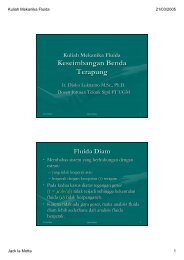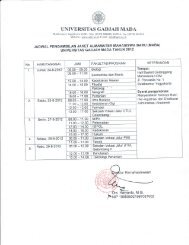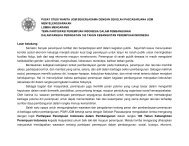Estimating the Codifference Function of Linear Time Series Models ...
Estimating the Codifference Function of Linear Time Series Models ...
Estimating the Codifference Function of Linear Time Series Models ...
You also want an ePaper? Increase the reach of your titles
YUMPU automatically turns print PDFs into web optimized ePapers that Google loves.
As a general conclusion, from this simulation studies, we may conclude that <strong>the</strong> optimal choice <strong>of</strong><br />
grid points s will follow <strong>the</strong> lines <strong>of</strong> our proposed choice <strong>of</strong> grid points s as in Section 3.1.<br />
4 Conclusion<br />
In this paper, we propose estimators <strong>of</strong> <strong>the</strong> codifference and <strong>the</strong> normalized codifference function,<br />
where for <strong>the</strong> linear processes with geometrically bounded coefficients and SαS innovations, we<br />
established <strong>the</strong> asymptotic properties <strong>of</strong> <strong>the</strong> proposed estimators. Notice that unlike <strong>the</strong> ACF<br />
estimator, we obtain that <strong>the</strong>re is no discontinuity in ei<strong>the</strong>r <strong>the</strong> normalization or <strong>the</strong> limiting<br />
distribution <strong>of</strong> <strong>the</strong> proposed estimators when α → 2. Moreover, we note that unlike <strong>the</strong> sample<br />
ACF which has an unfamiliar limiting distribution when α < 2 and relatively difficult to obtain <strong>the</strong><br />
quantiles <strong>of</strong> <strong>the</strong> limit distribution, estimators <strong>of</strong> <strong>the</strong> codifference and <strong>the</strong> normalized codifference<br />
will be asymptotically normally distributed at <strong>the</strong> same rate as <strong>the</strong> sample ACF in <strong>the</strong> classical<br />
case although <strong>the</strong> asymptotic variance is different. We also present a simulation study to observe<br />
<strong>the</strong> small sample properties <strong>of</strong> <strong>the</strong> normalized codifference estimator.<br />
In <strong>the</strong> practical situation, to obtain <strong>the</strong> estimates <strong>of</strong> <strong>the</strong> normalized codifference with a good<br />
accuracy for <strong>the</strong> real data, first we suggest to plot Re Î(k) within <strong>the</strong> interval s ∈ [0.01, 2], for<br />
some values <strong>of</strong> lag k > 0. These graphs will show two important things. First, <strong>the</strong>y suggest <strong>the</strong><br />
interval <strong>of</strong> s near zero which has a small bias (i.e., <strong>the</strong> interval 0.01 < s < s b , s b denotes <strong>the</strong><br />
threshold point <strong>of</strong> s where <strong>the</strong> graphs Re Î(k), for some k, are still relatively flat), as <strong>the</strong> best<br />
location for evaluating Î(·). Secondly, it reveals <strong>the</strong> erratic behavior <strong>of</strong> <strong>the</strong> estimates. When <strong>the</strong><br />
graphs are smooth, <strong>the</strong> choice <strong>of</strong> one point s = 0.01 is sufficient for estimating Re Î(k). If <strong>the</strong><br />
graphs are erratic, at least two points are required and more points are better for more erratic<br />
graphs. If <strong>the</strong> equidistant points s 1 , . . .,s r are considered, when <strong>the</strong> graphs are highly erratic, we<br />
can use a small distance between points, e.g., 0.01, where for less erratic graphs, we can use a<br />
bigger distance, such as 0.05 or 0.1. If <strong>the</strong> non equidistant points are used, we should include one<br />
point close to zero in <strong>the</strong> choice <strong>of</strong> s i ’s and <strong>the</strong> chosen points are sufficiently close to each o<strong>the</strong>r.<br />
Finally, we define <strong>the</strong> final estimate as <strong>the</strong> weighted average <strong>of</strong> <strong>the</strong> estimates at s 1 , . . .,s r .<br />
Notice that in this paper we have considered a method for calculating <strong>the</strong> codifference and<br />
<strong>the</strong> normalized codifference “directly” from <strong>the</strong> data. As an obvious alternative, once one knows<br />
<strong>the</strong> estimated parameters and <strong>the</strong> orders <strong>of</strong> <strong>the</strong> estimated models, one may directly estimate <strong>the</strong><br />
codifference and <strong>the</strong> normalized codifference using equation (6). The methods for estimating <strong>the</strong><br />
parameters <strong>of</strong> stable ARMA models have been reviewed in, e.g., Embrechts et al. (1997), Chapter<br />
7. Notice that for small order MA and AR processes, <strong>the</strong> tail index α can be well estimated using<br />
a quantile based estimator (i.e McCulloch’s method), see, e.g., Adler et al. (1998) for simulation<br />
evidences. In our opinion, for inference purpose, <strong>the</strong> “direct” estimation method is more preferable<br />
than estimating <strong>the</strong> codifference function via estimated parameters.<br />
Acknowledgement We wish to thank to D. Bauer for various discussions and helpful suggestions.<br />
The financial support for D. Rosadi from <strong>the</strong> Ministry <strong>of</strong> Science and Technology <strong>of</strong> Austria<br />
via ÖAD TSA Project is gratefully acknowledged.<br />
A Pro<strong>of</strong> <strong>of</strong> Theorem 2.1<br />
APPENDIX<br />
Before we give <strong>the</strong> lemmas which are necessary for <strong>the</strong> consistency pro<strong>of</strong> <strong>of</strong> <strong>the</strong> codifference estimator,<br />
a related result from Kokoszka and Taqqu (1994) will be presented, which shows <strong>the</strong><br />
codifference function in ARMA case is bounded by an exponentially decaying function just like<br />
<strong>the</strong> covariance function in <strong>the</strong> classical case. Kokoszka and Taqqu (1994) consider more general<br />
8


